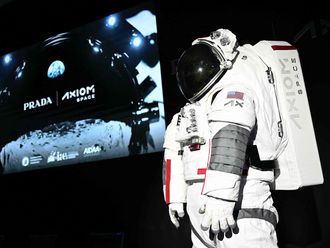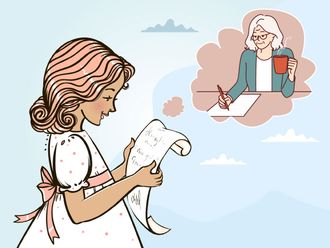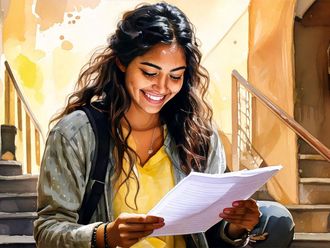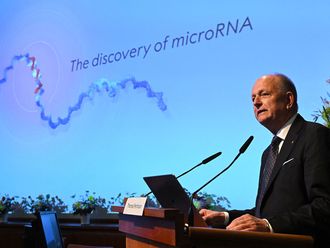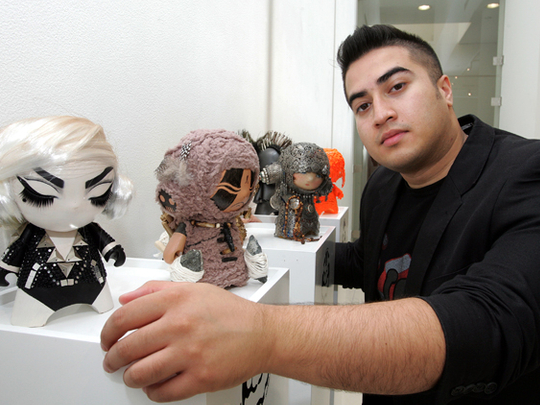
There is much that gives away his age. His clothes - grey cargo pants and a black T-shirt. His eyes - limpid and bright against unlined skin. His manner - nonchalant. But the weight of his words, as he reclines his frame, crossing his legs straight in front, conceal it - all 23 years.
The words moor his thoughts like anchors, forcing everyone to take notice. Take notice of him and his vision. Mohammad Abedin, an Emirati, reminds me of how easy it is to both love and hate success, especially when articulated by someone so young.
Precocious he is. Voluble too. At the Virgin Megastore outlet, Mall of the Emirates, where Abedin's customised toys are on display, we sit, talking. Rather, he talks, I listen.
Six weeks ago, he was at Bloomingdale's (The Dubai Mall) to work out the possibility of stocking his limited-edition collection of MEGA which, in its original form, is a white vinyl, 20cm tall customisable doll with adjustable and detachable arms, and 360˚ rotatable and detachable head, ears and back rocket. Bloomingdale's sold 200 pieces in a month, he says.
There are other denominators to his success. Take 100. The number of UAE-based professional artists he invited to design and customise the MEGA. All works under Project: MEGA went on display for a month at Gate Village at the DIFC (Dubai International Financial Centre) in May. And the money from the sales went directly to the artists.
Mo, as he likes to be called, says he wanted people to take notice. "If you aren't well-known, it is hard to make it. It is easy to be missed if you walk down the road alone, but if you walk with a hundred others, you cannot be missed."
Then in July, he worked with animal activist Samantha Stacey and a few local animal welfare organisations including Feline Friends, PETA and Dubai Animal Rescue Centre to raise awareness for adoption and foster care. He called the project MEGAnimals and used ten customised dolls to stage an awareness campaign, again at the Virgin outlet.
The MEGAs are hard to miss - their height notwithstanding. Even as we talk, people stride along the display of MEGAs, some from earlier projects, others from newer live art shows. They stop, stare, stay longer to look at the ones that pique their interest. Each doll has a unique avatar, ranging from the queer to the grotesque.
Yet, Mo tastes all but a soupcon of his success. "It hasn't hit me," he says. "I remember an incident at DIFC when I took out a customised MEGA and began to wipe the stand. A little girl tugged at her dad's sleeve, saying, ‘I want that toy.' And I thought to myself, ‘Wow, my work has touched someone'."
It's hard to associate these crowded mileposts of triumph with someone who has part gel-spiked hair, part military crop, and wears a large metal Foo Dog pendant that is both a symbol of the Chinese guardian lion and the name of his company. His vernal deportment is, at worst, misleading, at best, inspiring.
Recently he organised a workshop for kids at Ductac [The Dubai Community Theatre and Arts Centre], a venture to experiment at an entirely different level. "I used walls and couches as canvas, and got into trouble for doing so. These kids have newer ways to experiment. I want to help educate and empower them."
Still, I can't help but wonder whether Mo is riding his concept on an old, established product. The most obvious comparison to MEGA is Kidrobot, the creator of premier art toys like Dunny and Munny that were once at the Museum of Modern Art (MoMA), New York.
"Are you trying to be like Paul Budnitz, president and founder of Kidrobot?" I ask.
"No," says Mo, unsurprised. "I didn't model MEGA on his characters. The concept of customised toys originated in Japan. Budnitz was the first American to do it; I am the first Emirati. Many prefer MEGA over Munny. MEGA is curvy and seamless from the moment your paintbrush or pencil hits its vinyl canvas… you can draw without a crease. In our second series, we will introduce accessories and interchangeable parts."
Mo recalls the first sketch two years ago of the then unnamed MEGA. He had ridiculed the height of the toy. "It was small, but then I realised it can have a big impact. I called it MEGA," he says.
I, ME, MYSELF
I was rubbish when I started out with MEGA. I was a concept comic book artist and had no idea how to go about creating a toy. I used to hand draw characters like X-Men, Spiderman and other action figures. I would take Japanese cartoons and redraw them with American features, mainly with broader chins and thicker gridline inking.
At 19, I started on the first concept comic book in the UAE as the lead artist with Abdul Rahman Mohammad, an artist. He created a storyline with characters called the Petroneans who were a product of mutation caused by the region's oil and part of a project known as Jenova. It was on the front page of a local daily. (The book is still in the pipeline.)
With MEGA, I had to teach myself everything, and was amazed at how easy it is to learn something if you are willing to. The internet helped with online videos and related material. I read and spoke to people. I didn't like the shape of existing toys and wanted to create one of my own.
I started drawing by hand, beginning with the most defining feature - the nose. If I drew it crooked, it could look evil. Too small, too thick or too long… would give it an identity.
Eventually the sketch went from paper to Illustrator and then arrived as a prototype at my doorstep.
I found everything I ever wanted in one place - Tokyo. I was part of a group of 14 students who were to act as ambassadors to universities in Tokyo, Brisbane, Hong Kong and Bangkok.
It was serendipity. I wasn't supposed to be part of the group. I was two semesters behind during my Bachelor's Degree in Business Administration at the Dubai Men's College, but was chosen to replace another student as I had an excellent academic record.
As far as I can remember, I had always wanted to visit Tokyo. For ten days I wandered the streets seeing everything I was passionate about: animations, designer toys, comics, graphic novels and urban art. I came back with thoughts of creating a toy.
I am Emirati, but I never had the opportunity to learn Arabic. I get lectured about this by the older generation. I can read though and understand the semantics to a degree.
My father, originally from Saudi Arabia, is a polyglot; he can speak more than 15 languages, including Thai. My mum has Chinese and Thai ancestry. When growing up in Thailand, Saudi Arabia and then in the UAE, we spoke mostly Thai. Outside our home, we siblings - Jameel, Maryam and Boy - spoke English with our friends. Even in Saudi Arabia we spoke in English because we were surrounded by Greek, Turkish, Pakistani and Indian expatriates. I admit, I have taken a few lessons in Arabic.
I, ME, MYSELF
Me and my ideals
You must compare yourself to the best. I looked up to comic book artists like Humberto Ramos best-known for Crimson and Joe Madureira who got famous for his work on Marvel Comics' Uncanny X-Men and his creator-owned book Battle Chasers. Madureira was barely 17 when he got his break, pencilling the first Deadpool miniseries.
I started following their work. My friends would see my sketches and comment saying they were good. I didn't think they were good enough. "Why are you comparing yourself to professionals?" they would ask.
Me and taking risks
I never told anyone about MEGA, except my close friend and now business partner Prathibha Edirisuriya. I just did it. So when the prototype was delivered, my family was surprised. I had quit my job in the bank where I had worked for four years and told my parents that I was going to take up designing. They had no clue it was to do with a toy.
I took a big risk. For one, I quit a full-time job to take up something that didn't guarantee financial rewards. The monthly cash flow stopped. But I asked myself, ‘What is the worst that could happen?' I had my support system - family and friends, worth more than anything in the world. They were going to be there if I needed them. They were going to be there whether I succeeded or failed.
I live for a lot of what everyone else lives for. The only difference is, being an ‘artrepreneur', I like to take more risks. While not always a great thing, it definitely eliminates the ‘what if' factor. Along the way, I hope that someone was inspired by something I did.
Me and MEGAs
MEGA is like my son, my boy. I see him differently. MEGA doesn't have a gender and yet I prefer to address it as he. When I saw his prototype, I just stared at it with utter disbelief and admiration. It was beautiful. He is more than a toy, more than my creation.
Others buy it because it is a toy. They don't realise what it took to create it with my own money, not knowing what was in store. MEGA represents accomplishment, tenacity and perseverance. It fills me with pride when I see MEGA getting recognition in the West because the box he comes in has my full name, Mohammad Abedin, which links me to this region.
I, ME, MYSELF
Psychological research hints that a core element to leading a happy life is to spend part of your time thinking about ideas or purposes that are bigger than you are. Comment.
My purpose is to start an artistic revolution of sorts in this region. I have always had a bigger cause in mind. It was never about making money off a toy. I wanted to promote collaboration among artists and give them exposure.
I support creative minds and try to make sure that their creativity isn't wasted. Do you know that some of the most brilliant works on MEGAs are done by those who are not artists by profession? They are engineers, receptionists, insurance agents… I want to see this country give birth to more artists. I want to be able to visit Europe and see names of artists from this region.
We are using technology with such abandon to create art that we are even mistaking art created through iPad apps such as Brushes, ArtStudio and Sketchbook Pro for canvas paintings. Do you agree?
Isn't that a good thing? I was a comic book artist now I am a digital artist. Technology gives you more room to explore.
But whether you work on a canvas or screen, you work just as hard. It is not how, but the idea behind the work that is of importance.
If you want to know whether there will ever be another Mona Lisa, the answer is no. The same answer applies to Roald Dahl or The Beatles of this world. Unfortunately, no idea is absolutely new; we reinterpret.
You've had to give something up to gain what you have. It seems so easy to apply the economic principle behind opportunity cost - where you can do any one thing at the expense of doing another - to your life. You have lost out on the pleasure of being a carefree youngster. Your thoughts?
Yes, I have made sacrifices. I was too fast, too serious. I took it upon myself; I was never pressurised. The good thing about being young is that you don't realise the full extent or think about the sacrifices too much. Doing what I have done has made me a more mature person.
I wanted to study fine arts in Canada, but it was too expensive so I opted for business studies here. Yet, I took time to study art on my own. Some of my peers ask, "How come you have done so much?" The answer is simple. I used my time differently. I didn't party or hang out with friends. Neither did I get up to crazy antics. I worked hard, even when I was sick. When I resigned from my bank job, my friend and documentary film-maker Katy Chang told me I ought to realise that I would now be working for the world's toughest boss - myself.



